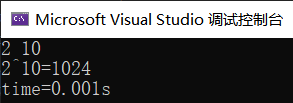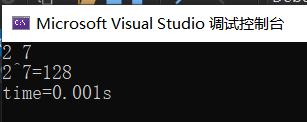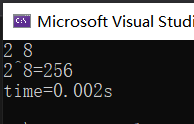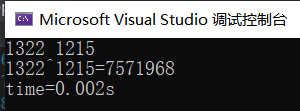
快速幂——高精度求幂
发布日期:2021-05-08 07:47:33
浏览次数:21
分类:原创文章
本文共 4482 字,大约阅读时间需要 14 分钟。
文章目录
前言
本文讲述快速幂的原理,以及用法
一、快速幂(Fast Exponentiation)的定义:
定义:快速求,取base为底数的exp次幂,即求:baseexp;
时间复杂度: O(log₂N)
二、快速幂原理:
思想:每一步都把指数分成两半,而相应的底数做平方运算。不仅能把非常大的指数给不断变小,所需要执行的循环次数也变小,而最后表示的结果却一直不会变。
原理:(a* b) % m = ((a % m) * (b % m)) % m
三、常规求幂:
代码块:
#include <bits/stdc++.h>using namespace std;typedef long long ll;ll Pow1(ll my_base, ll my_exp) { ll ans = 1; for (int i = 1; i <= my_exp; i++) ans *= my_base; return ans;}int main() { ios::sync_with_stdio(false); cin.tie(0); //断开同步流 ll my_base, my_exp, result; clock_t my_start, my_end; cin >> my_base >> my_exp; my_start = clock(); //该函数返回值是硬件滴答数 result = Pow1(my_base, my_exp); cout << my_base << "^" << my_exp << "=" << result << endl; my_end = clock(); cout << "time=" << ((double)my_end - my_start) / CLK_TCK << "s" << endl; //要换算成秒,需要除以CLK_TCK或者 CLK_TCKCLOCKS_PER_SEC return 0;}运行结果:

四、简单快速求幂:
代码块:
#include <bits/stdc++.h>using namespace std;typedef long long ll;ll Pow2(ll x, ll y) { ll ans = 1, base = x; while (y != 0) { if (y % 2 != 0) ans *= base; base *= base; y /= 2; } return ans;}int main() { ios::sync_with_stdio(false); cin.tie(0); //断开同步流 ll my_base, my_exp, result; clock_t my_start, my_end; cin >> my_base >> my_exp; my_start = clock(); //该函数返回值是硬件滴答数 result = Pow2(my_base, my_exp); cout << my_base << "^" << my_exp << "=" << result << endl; my_end = clock(); cout << "time=" << ((double)my_end - my_start) / CLK_TCK << "s" << endl; //要换算成秒,需要除以CLK_TCK或者 CLK_TCKCLOCKS_PER_SEC return 0;}运行结果:

四、递归快速求幂:
代码块:
#include <bits/stdc++.h>using namespace std;typedef long long ll;ll Pow3(ll my_base, ll my_exp) { if (my_exp == 1)return my_base; ll ans = Pow3(my_base, my_exp / 2); return (my_exp % 2 == 0 ? 1 : my_base) * ans * ans;}int main() { ios::sync_with_stdio(false); cin.tie(0); //断开同步流 ll my_base, my_exp, result; clock_t my_start, my_end; cin >> my_base >> my_exp; my_start = clock(); //该函数返回值是硬件滴答数 result = Pow3(my_base, my_exp); cout << my_base << "^" << my_exp << "=" << result << endl; my_end = clock(); cout << "time=" << ((double)my_end - my_start) / CLK_TCK << "s" << endl; //要换算成秒,需要除以CLK_TCK或者 CLK_TCKCLOCKS_PER_SEC return 0;}运行结果:

五、位运算快速求幂:
代码块:
#include <bits/stdc++.h>using namespace std;typedef long long ll;ll Pow3(ll my_base, ll my_exp) { int ans = 1, base = my_base; while (my_exp != 0) { if (my_exp & 1 != 0) { //逐位获取b的二进制位,遇0累乘 ans *= base; } base *= base; my_exp >>= 1; } return ans;}int main() { ios::sync_with_stdio(false); cin.tie(0); //断开同步流 ll my_base, my_exp, result; clock_t my_start, my_end; cin >> my_base >> my_exp; my_start = clock(); //该函数返回值是硬件滴答数 result = Pow3(my_base, my_exp); cout << my_base << "^" << my_exp << "=" << result << endl; my_end = clock(); cout << "time=" << ((double)my_end - my_start) / CLK_TCK << "s" << endl; //要换算成秒,需要除以CLK_TCK或者 CLK_TCKCLOCKS_PER_SEC return 0;}运行结果:

六、高精度快速求幂:
代码块:
#include <bits/stdc++.h>using namespace std;typedef long long ll;const ll mod = 1e7; //自定义取模的数据,视数据大小的情况而定//a ^ bll ksm(ll a, ll b, ll mod) { //time_complex=O(logn) ll ans = 1, base = a; while (b != 0) { if ((b & 1) != 0) { //“b & 1”指取b的二进制数的最末位 ans = (ans * base) % mod; //累乘,以便随时对ans做出贡献。 } base = (base * base) % mod; b >>= 1; //右移1位,删去最低位。 } return ans;}int main() { ios::sync_with_stdio(false); cin.tie(0); //断开同步流 ll a, b, result; clock_t my_start, my_end; cin >> a >> b; my_start = clock(); //该函数返回值是硬件滴答数 result = ksm(a, b, mod); cout << a << "^" << b << "=" << result << endl; my_end = clock(); cout << "time=" << ((double)my_end - my_start) / CLK_TCK << "s" << endl; //要换算成秒,需要除以CLK_TCK或者 CLK_TCKCLOCKS_PER_SEC return 0;}运行结果:

六、python高精度快速求幂:
代码块:
a, b = map(int, input().split())mod = 10000000result = pow(a, b, mod)print("{0}^{1}={2}".format(a, b, result))运行结果:

七、实战演习:
题目来源:


程序代码:
第一种写法:
#include<bits/stdc++.h>using namespace std;typedef long long ll;/*long long qmod(ll a,ll b,int c){ if(b==1) return a; if(b&1) return a*qmod(a,b-1,c)%c; else { ll m=qmod(a,b/2,c); return m*m%c; } } *///用二分还是超时ll qmod(ll a,ll b,ll c)//快速幂{ int r=1; while(b) { if(b&1) r=a*r%c; a=a*a%c; b>>=1; //b的二进制形式删除最后一位 } return r;}int main(){ long long a,b,c; c=998244353; cin>>a>>b; if(a>c) a=a%c; else { ll ans=qmod(b+1,a,c); cout<<ans<<endl; } }第二种写法:
n, m = map(int, input().split())sum = pow(m+1,n,998244353)print(sum)运行结果:

总结
本文讲述快速幂的基本用法。
如有错误,敬请指教!
发表评论
最新留言
初次前来,多多关照!
[***.217.46.12]2025年04月15日 00时00分05秒
关于作者

喝酒易醉,品茶养心,人生如梦,品茶悟道,何以解忧?唯有杜康!
-- 愿君每日到此一游!
推荐文章
MATLAB——操作矩阵的常用函数
2019-03-05
CMake自学记录,看完保证你知道CMake怎么玩!!!
2019-03-05
Eigen库中vector.transpose()函数什么意思
2019-03-05
ORB-SLAM2:LocalMapping线程学习随笔【李哈哈:看看总有收获篇】
2019-03-05
ORB-SLAM2:LoopClosing线程学习随笔【李哈哈:看看总有收获篇】
2019-03-05
牛客练习赛56 D 小翔和泰拉瑞亚(线段树)
2019-03-05
hdu6434 Problem I. Count(数论)(好题)
2019-03-05
NC15553 数学考试(线性DP)
2019-03-05
MySQL两阶段提交、崩溃恢复与组提交
2019-03-05
MySQL隐藏文件.mysql_history风险
2019-03-05
如何通过文件解析MySQL的表结构
2019-03-05
ClickHouse 适用场景调研文档
2019-03-05
C++的编译过程及原理
2019-03-05
Vue——父组件将方法传递给子组件
2019-03-05
文件加密软件对于企业发展而言有何优势?局域网数据防泄密工作应该如何入手?
2019-03-05
Beautiful Soup基础入门
2019-03-05